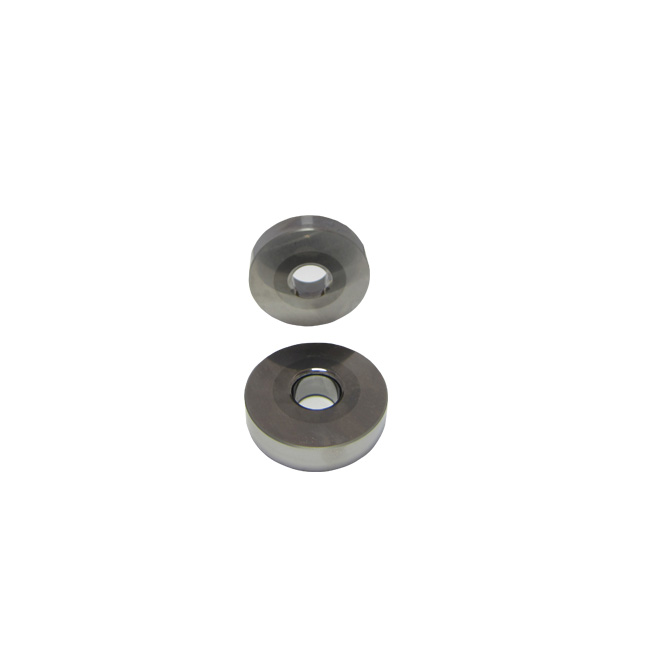 Drawing dies are typically made of tool steel, tungsten carbide, or diamond, with tungsten carbide and manufactured diamond being the most common. Synthetic diamond is usually used in the early stages of the drawing process, whereas natural diamond dies are used in the final stages. For drawing very fine wire a single crystal diamond die is used. For hot drawing, cast-steel dies are used. For steel wire drawing, tungsten carbide dies are used. The dies are placed in a steel casing, which backs the die and allows for easy die changes. Die angles usually range from 6–15°, and each die has at least 2 different angles: the entering angle and approach angle. Wire dies usually are used with power to pull the wire through them. There are coils of wire on either end of the die which pulls and rolls up the wire with a reduced diameter.
Drawing dies are typically made of tool steel, tungsten carbide, or diamond, with tungsten carbide and manufactured diamond being the most common. Synthetic diamond is usually used in the early stages of the drawing process, whereas natural diamond dies are used in the final stages. For drawing very fine wire a single crystal diamond die is used. For hot drawing, cast-steel dies are used. For steel wire drawing, tungsten carbide dies are used. The dies are placed in a steel casing, which backs the die and allows for easy die changes. Die angles usually range from 6–15°, and each die has at least 2 different angles: the entering angle and approach angle. Wire dies usually are used with power to pull the wire through them. There are coils of wire on either end of the die which pulls and rolls up the wire with a reduced diameter.
What is Wire Drawing?
The reduction of the diameter of a metal rod or wire by pulling it through a die. The working region of dies is typically conical. The tensile stress on the drawn wire, that is, the drawing stress, must be less than the wire’s yield strength. Otherwise, the drawn section will yield and fail without pulling the undrawn wire through the die. Because of this limitation on the drawing stress, there is a maximum reduction that can be achieved in a single drawing pass. After large drawing reductions, wires or rods develop crystallographic textures or preferred orientations of grains. The textures are characteristic of the crystal structure of the metal.
Making of wire, generally from a rod or bar. The wire-drawing process consists of pointing the rod, threading the pointed end through a die, and attaching the end to a drawing block. The block, made to revolve by an electric motor, pulls the lubricated rod through the die, reducing it in diameter and increasing its length. Fine wire is made by a multiple-block machine because the reduction cannot be performed in a single draft.
Hot extrusion is widely used in the production of pipes and profiles of non-ferrous metals such as aluminum and copper and belongs to the metallurgical industry. The hot extrusion of steel is used to produce special pipes and profiles, as well as carbon steel and alloy steel parts that are difficult to form with cold or hot extrusion, solid and core (through holes or through holes), such as A rod with a large head, a barrel, a container, and the like. The dimensional accuracy and surface finish of hot extrusions are superior to hot forgings, but the joints still need to be finished or machined.
Cold extrusion machine
Cold extrusion was originally only used to produce pipes, profiles, lead pipes, zinc, tin, aluminum, copper, etc., as well as toothpaste hoses (lead of lead-tin), dry battery shells (zinc), and shells (copper). Cold extrusion technology began in the mid-20th century for carbon structural steels and alloy structural steels, such as rods and rods of various cross-section shapes, piston pins, wrench sleeves, spur gears, etc., and later Squeeze some high carbon steel, rolling bearing steel, and stainless steel parts. Cold extrusions have high precision and a smooth surface and can be used directly as parts without cutting or other finishing. The cold extrusion operation is simple and suitable for small parts produced in large quantities (steel extrusions are generally not larger than 100 mm in diameter).
Warm extrusion is an intermediate process between cold extrusion and hot extrusion, and the use of warm extrusion under suitable conditions can combine the advantages of both. However, the warm extrusion requires heating of the blank and the preheating mold. The high-temperature lubrication is not ideal, and the mold life is short, so the application is not extensive.





